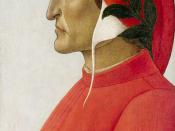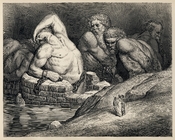Dante's Inferno
Many descriptions have been given of hell; however, Dante's portrayal of this pit of anguish puts hell into a different perspective for myself. The separating of levels or degrees, the personification of the sinners, and the comparison to what I have learned in the past makes Dante's Inferno a captivating poem that will always be considered a classic with universal content.
Dante is a wonderful poet because of his ability to connect with the reader no matter what generation. Inferno was published in 1932, 71 years ago, and I was still able to connect with it and comprehend this incredible poem at the same time. Dante's universality makes the degrees of hell understandable. The illustration he draws of hell is one that is actually imaginable when reading. I could picture the funnel of hell, with the substantial sized opening whittling down to a diminutive enclosure that gives new meaning to the saying, "Jaws of hell."
Also, the imagery of the Forest of Death and the Mountain of Delight leading to the 10* of Hell that cut down until the steps of Purgatory reach Heaven, gives the journey of after life a creative touch that is conceivable. This journey into the depths of hell is only plausible because of the spectacular descriptions of the sinners spending eternity in hell.
The types of sinners that Dante places into hell vary in stature. For example, Cleopatra is doomed to infinity in one of the upper levels of hell. The first level of hell, Limbo, is for sinners who were not Christians or who had failed to be baptized. Another example is to the opposite extreme, the last degree where only one sinner has been placed. That sinner is Judas Iscariot who is in the last ring because of his betraying and...


